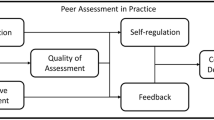Abstract
This paper applies the mathematical technique of Data Envelopment Analysis to the problem of appraisal in Higher Education. The technique can be understood as an idealised self and peer appraisal: evaluating others in the same way that we would optimally evaluate ourselves relative to those others. The technique is applied to examples of student and staff appraisal. Although the main focus of this article is on the technique itself (its rationale, the prerequisites for use, and the insights that it yields), we also discuss the wider implications of having and using such a technique to assist appraisal.
Similar content being viewed by others
References
Adolphson, D.L., Cornia, G.C., and Walters, L.C. (1991). ‘A unified framework for classifying DEA models’, in Bradley, H.E. (ed.),Operational Research '90. Oxford: Pergamon Press.
Beasley, J.E. (1990). ‘Comparing university departments’,OMEGA, International Journal of Management Science 18(2), 171–183.
Bessent, A.M., and Bessent, E.W. (1980). ‘Determining the comparative efficiency of schools through Data Envelopment Analysis’,Educational Administration Quarterly 16(2), 57–75.
Bessent, A.M., Bessent, E.W., Charnes, A., Cooper, W.W., and Thorogood, N.C. (1983). ‘Evaluation of educational program proposals by means of DEA’,Educational Administration Quarterly 19(2), 82–107.
Boisot, M.H. (1986). ‘Markets and hierarchies in a cultural perspective’,Organization Studies 7(2), 135–158.
Carson, K.P., Cardy, R.L., and Dobbins, G.H. (1991). ‘Performance appraisal as effective management or deadly management disease’,Group and Organization Studies 16(2), 143–159.
Doyle, J.R., and Green, R.H. (1991). ‘Comparing products using Data Envelopment Analysis’,OMEGA, International Journal of Management Science 19(6), 631–638.
Doyle, J.R., and Green, R.H. (1994). ‘Efficiency and cross-efficiency in DEA: Derivations, meanings and uses’,Journal of the Operational Research Society, 45(5), 567–578.
Johnes, G., and Johnes, J. (1993). ‘Measuring the research performance of UK economics departments: An application of Data Envelopment Analysis’,Oxford Economics Papers 45, 332–347.
Hartley, R. (1985).Linear and Non-linear Programming: An Introduction to Linear Methods in Mathematical Programming. Chichester, UK: Ellis Horwood.
Kahneman, D., Solvic, P. and Tversky, A. (1982).Judgement Under Uncertainty. Cambridge: Cambridge University Press.
Kleinmutz, B. (1990). ‘Why we still use our heads instead of formulas: towards an integrative approach”,Psychological Bulletin 107(3), 296–310.
Nisbett, R.E., and Ross, L. (1980).Human Inference: Strategies and Shortcomings of Social Judgement. Englewood Cliffs, NJ: Prentice-Hall.
Norman, M., and Stoker, B. (1991).Data Envelopment Analysis: The Assessment of Performance. Chichester, UK: Wiley.
Nunamaker, T.R. (1985). ‘Using Data Envelopment Analysis to measure the efficiency of non-profit organizations: a critical evaluation’,Managerial and Decision Economics 6(1), 50–58.
Oral, M., Kettani, O., and Lang, P. (1991). ‘A methodology for collective evaluation and selection of industrial R&D projects’,Management Science 37(7), 871–885.
Roll, Y., and Golany, B. (1933). ‘Alternative methods of treating factor weights in DEA’,OMEGA, International Journal of Management Science 21(1), 99–109.
Ross, L. (1977). ‘The intuitive psychologist and his shortcomings’, in Berkowitz, L. (ed.),Advances in Experimental Social Psychology (vol. 10). New York: Academic Press.
Sexton, T.R., Silkman, R.H., and Hogan, A.J. (1986). ‘Data Envelopment Analysis: critique and extensions’, in Silkman, R.H. (ed.),Measuring Efficiency: An Assessment of Data Envelopment Analysis. San Francisco: Jossey-Bass.
Smith, P., and Mayston, D. (1987). ‘Measuring efficiency in the public sector’,OMEGA International Journal of Management Science 15(3), 181–189.
Stillwell, W.G., Barron, F.H., and Edwards, W. (1983). ‘Evaluating credit applications: a validation of multiattribute utility weight elicitation techniques’,Organizational Behavior and Human Performance 32, 87–108.
Times Higher Educational Supplement (1993). 14 May.
Tomkins, C.R., and Green, R.H. (1978). ‘An experiment in the use of Data Envelopment Analysis for evaluating the efficiency of UK university departments of accounting’,Financial Accountability and Management 4(2), 147–164.
Author information
Authors and Affiliations
Rights and permissions
About this article
Cite this article
Doyle, J.R., Green, R.H. Self and peer appraisal in higher education. High Educ 28, 241–264 (1994). https://doi.org/10.1007/BF01383731
Issue Date:
DOI: https://doi.org/10.1007/BF01383731




